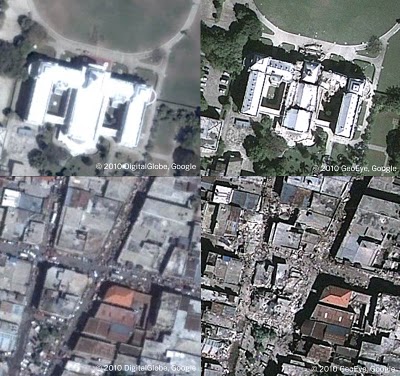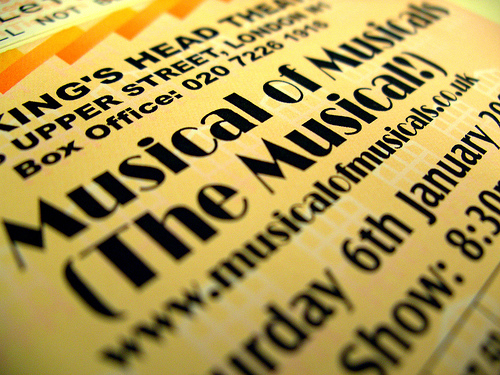Site informationRecent Blog Posts
Blog Roll
|
Writing ExerciseGoogle Earth Pedagogies: From Haiti to RHE 306
Submitted by Laura T. Smith on Mon, 2010-02-08 13:41
Image Credit: Google Lat Long Blog If were you watching the news in mid-January, you likely saw images like those above flashing repeatedly across your television or computer screen. Unlike the photojournalistic, street-level portraits that tend to document disasters, these aerial shots, produced through a collaboration between Google Earth and GeoEye (a satellite imaging company), have been prominent in the visual coverage of the earthquake that hit Haiti on January 12, 2010. The above images show pre- and post-quake views of the Presidential Palace (top left; top right) and downtown Port au Prince (bottom left; bottom right), and were created using the timeline tool in Google Earth. Delivery and Comparative Rhetorical Analysis
Image Credit: Phil Gyford For a handout, download the PDF document outlining this assignment. Notes for the Instructor: The design of this unit is to teach students to do analysis of visual media like musicals, which include song and dance as well as traditional scripts and visual elements, by focusing on the issues of rhetorical delivery (specifically, the performance of the actors within the stage/camera shot, and the visual elements associated with that performance). This unit was built to go after a more traditional unit that focused on analyzing the lyrical content of musicals’ songs, and to encourage students to tie lyric to delivery. The elements of the unit included as follows: Week 1: Introduce terminology of delivery, do comparative analysis of examples in class. Week 2: Watch two versions of a full-length musical and analyze them in class. Week 3: Write a short comparative rhetorical analysis (1-2 pages in length), bringing in new material to go with material already covered in class. Week 4: Write and workshop full-length (5-7 pages) paper.
Goals: The goals of this unit were to make students aware of visual forms of rhetoric and the delivery within performance contexts, as well as to make them consider how those gestures work to constitute meaning along with more traditional elements (like words and lyrics). This unit is also to help them expand their researching skills by learning how to research in multiple venues (electronic and non-electronic, performance reviews, books on composers and lyricists, etc). Visual Rhetoric Writing Exercise
Submitted by Nate Kreuter on Mon, 2007-04-16 09:56
I recently incorporated the Garry Winogrand photo below into an in-class writing exercise. The exercise is essentially the same as one that I came up with when helping Brooks Landon teach his Prose Style course at the University of Iowa a few years ago. Keep reading to learn more about the writing exercise.
I bring a photo in to class, usually one that depicts something weird, something that probably has a story behind it but that doesn't make that story explicit. I project the photo and don't tell the students a word about it, not when it was taken, by whom, nothing. Then the students have to write about the photo. It's a creative assignment and in this case I was trying to get them to think about form. Specifically, after a workshop on the subject in the prior class, I was asking them to write "cumulative" sentences. Cumulative sentences, for those of you who aren't prose style junkies, are described in Francis Christensen's essay "A Generative Rhetoric of the Sentence." So, the photo was just a prompt to get the students writing in a new mode that we had been working on. The exercise went very well and my students generated some whacky, but stylistically adventurous, prose. If I get their permission, I will post some of their writings in the comments soon. Comparison and Rhetorical AnalysisNotes for the Instructor: This is a unit-long assignment, which asks the students to write first a short paper (300–500 words), in which they compare two images/objects/spaces and their respective messages, and then produce a long essay (4–5 pages), in which they incorporate the text they have already produced in the short paper, but make an argument about the rhetorical effectiveness of the two images/objects. In other words, in the short paper they discuss message alone; in the long paper they discuss both the message and its reception. The assignment involves doing extensive research into the respective culture/ideology, which produced the images/objects. Both the short and the long essay should contain a rhetorically crafted, comparative description of the images/objects, which should serve to set up the main argument, i.e., to make the reader more receptive to it. Here are two sample arguments (quoted with the students’ permission):
Assignment Description: Write a short comparison, which leads to the creation of a rhetorical analysis. Category: Individual Project. Goals: This assignment has several goals: a) to give the students the opportunity to realize that successful arguments about rhetorical effect can be quite complex and require much research, b) to give them a chance to revise and incorporate some of their own writing into longer pieces of text with different goals, c) to help them realize that no description or comparison is “neutral;” all descriptions/comparisons have a particular rhetorical goal and audience, and their language and selection of elements is important. Short EssayChoose two closely related images/objects, which are at least fifty years old and write a short essay (300–500 words), in which you make a comparative claim about their respective messages. In order to make a sustainable claim, you will need to research the historical and cultural context in which the images/objects first appeared. Before you begin, consider again the following questions:
Requirements:
Grading Criteria:
Long EssayBuilding on your short paper, write a long argumentative essay (4-5 pages), in which you make a comparative argument about the rhetorical effectiveness of two closely related images/objects. Your images/objects must be at least fifty years old. In order to make a sustainable claim, you will need to research the historical and cultural context in which the images/objects first appeared. You claim must involve the ideologies and messages of your images/objects as well as the reception of those messages. Before you begin, consider again the following questions:
Requirements:
Grading Criteria:
Proposal assignmentNotes for the Instructor: This proposal assignment offers visually-oriented alternatives to the traditional essay and gives students the opportunity to create a web site, a short film, or a PowerPoint presentation. Attached are two examples of PowerPoint presentations, a rough draft and a final draft that has been revised for aesthetic and persuasive appeal. To implement this assignment, the instructor will need to specify a more exact prompt and the specific guidelines necessary to complete the project (for example, the length of a short film [recommended: 5–10 minutes] or PowerPoint presentation [recommended: 20 minutes]), the number and type of sources to be used (the assignment currently requires a minimum of five), the grading specifications, and the due dates. Assignment Description: Creating a proposal argument Category: Individual project Goals: This project is designed give students practice in producing visual proposal arguments; to lead them to demonstrate facility with the tools of visual rhetoric; and to think critically and carefully about the relationship between aesthetics and arguments, or between visual rhetoric and persuasion. Students will research a specific proposal and create a web site, a PowerPoint Presentation, or a short film as the medium for presenting their proposal argument. The objective is to present a well thought-out proposal that offers a viable solution to an issue that interests you, and that identifies a specific plan of action for your reader. Tasks:
Guidelines:
Topic Proposals: Your topic proposal should include the following:
Rough Draft: Your web site or short film should be fairly well fleshed out, and although they may not have all of the content you plan to incorporate into the final product, they should be close to the completed stage. If you elect to do a PowerPoint presentation, you should have all of your slides set up (even if you plan to revise them), and you should also have a Word document summarizing what you plan to say about each slide. Grading: These projects will be graded for their visual as well as textual content; the visual component and presentation will account for 25% of your assignment grade, and the textual component will account for the remaining 75%. Be sure to include a bibliography (yes, even for short films). PowerPoint 101Notes for the Instructor: This assigment is designed to introduce students to Microsoft's PowerPoint presentation software. Students are asked to work in groups and create presentations related to the content of the course (the instructor may wish to generate a list of acceptable topics). This assignment is designed to last no more than 2 or 3 class meetings: students will choose (or be assigned) their groups and topics, work on the presentations outside of class, and then present them to their peers. Students are also asked to submit a two-page paper describing the process of working on the project; instructors may choose to tweak this aspect of the assignment according to the goals of the course. Assignment Description: Becoming familiar with PowerPoint Category: Group project Goals: This project is designed to introduce students to Microsoft’s PowerPoint software and give them practice in using it by producing an organized presentation to be given in class. Tasks:
Guidelines:
Suggestions: Groups will be given some time to work on their projects in class, but are also expected to meet at least once outside of class to discuss the topic, plan the presentation, and divide different responsibilities among members of the group. |
viz.
Visual Rhetoric - Visual Culture - Pedagogy
Site informationRecent Blog Posts
|
Writing Exercise |



Recent comments
2 years 29 weeks ago
2 years 44 weeks ago
2 years 44 weeks ago
2 years 50 weeks ago
3 years 4 weeks ago
3 years 4 weeks ago
3 years 4 weeks ago
3 years 6 weeks ago
3 years 6 weeks ago
3 years 6 weeks ago